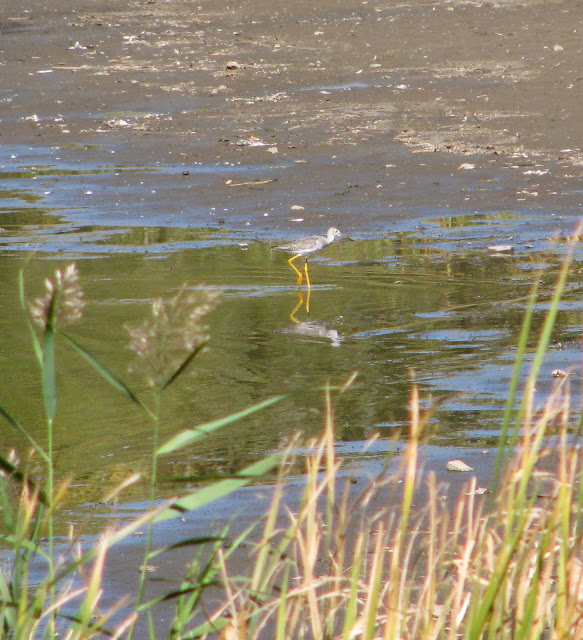 |
| New signage on Furhrmann right across from Times Beach Entrance |
I usually like to keep the Protection Farm Journal focused on Protection Farm, but we have a wonderful relationship with Times Beach Nature Preserve, which is located in, downtown Buffalo on the Waterfront. Among other things we host a Facebook page called Friends of Times Beach Nature Preserve:
Facebook Friends of Times Beach Nature Preserve
 |
| Jonna and Jamie |
This past Saturday 10-09-10 Jamie, Jonna, and I, went down early on a photo safari and were greeted with spectacular things. The water was a little low, which is typical in the fall, and is very inviting for migrating shorebirds. Times Beach is known for fall migrating shorebirds. They are an important part of the 423 species that have been seen at Times Beach over the years.
A pair of American avocets were in the water near a shoreline mudflat, about half way out from the western end breakwall from where we were observing. At first I did not know what they were. They were about 25 yards off shore, off the mudflats and at least 100 yards from where we stood. They appeared to be floating, and because of the distance from us, they appeared to be a pair of floating gulls. They were white with some black wing markings, and I did not get my glasses on them at first. That is because I was immediately distracted by three Greater Yellowlegs, which were almost next to us on the nearby mudflats.
 |
| Looking toward downtown, mudflats exposed center and left |
These Yellowlegs were incredible looking. They were walking back and forth, in and out of the water, and seemed to be playfully hunting for food. They had brilliant and long yellow legs. They were very tall and elegant. I have always loved watching these birds. Basically, I felt that if I didn’t see another bird this day, I would be very happy with the Yellowlegs. Every once in a while they would take flight, with the familiar 3-chirp vocalization that helps to characterize their identification. They are similar to the Lesser-Yellowlegs, which you can also find at Times Beach, but they are larger. They would fly together back and forth across the mudflats, sometimes very close, sometimes, about 75 yards away from us. We watched for several minutes before I finally decided to get my glasses on the white gulls floating offshore.
 |
| Avocets center tiny white specks to the left of central mudflats |
 |
| Not a great photo because it is digitally zoomed but you can see the slender black upturned bills |
I couldn’t believe what I saw. They were still in deep water, but the markings on their backs were not any gull markings that I recognized. As I got a closer look at the heads I realized that they had long slender upturned beaks. And then they started to move toward the shore. And I realized that they were walking. They slowly rose out of the water as they approached the relative shallows just off the mudflats. When I say slowly rose out of the water, I mean they elevated out of the water on these incredible long stilts for legs. They were hugely tall. Easily half again as big as the Yellowlegs. They were almost as big as the Blue-heron that had just landed about 20 yards to their north.
 |
| American Avocet (Recurvirostra americana) pair at Times Beach, Saturday October 9, 2010 |
 |
| They walk with such elegance |
I think that this is a male and female, as there are subtle differences. We watched for about half an hour as they meandered back and forth around the mudflats, in and out of the deep water, moving their heads and necks back and forth in the water as they searched for food. These rare and stunning birds were just incredible to observe and really put an exclamation point on why Times Beach is such an important nature preserve on the Great Lakes.
 |
| Greater Yellowlegs (Tringa melanoleuca) |

After a while there was a commotion in the cattails near the far end of the mudflats. Three deer, a family, -an antlered father, a mother and a young yearling emerged on the mudflats. They were enjoying the day and were very playful. They were chasing each other around in circles, rearing up hind legs and tagging each other with the front legs, and the yearling kept going to nurse from the mother, which she resisted with some determination. At one point, they noticed the Blue-heron and the avocets and I have a great photo of them checking them out.
What a day at Times Beach!

 |
| New paved roadway and parking at west entrance |
 |
| New light standards along bike path |


















































